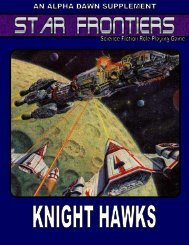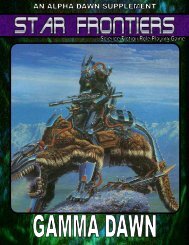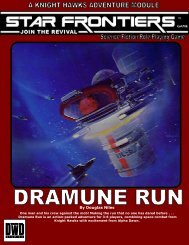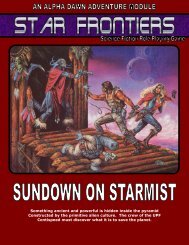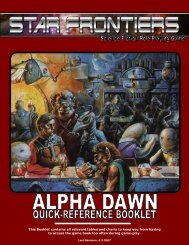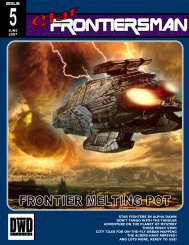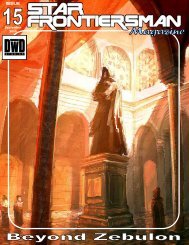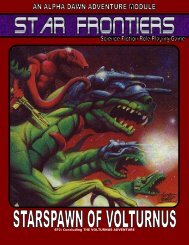Alpha Dawn - Star Frontiersman
Alpha Dawn - Star Frontiersman
Alpha Dawn - Star Frontiersman
Create successful ePaper yourself
Turn your PDF publications into a flip-book with our unique Google optimized e-Paper software.
across an open area, they must move straight at a<br />
constant speed until they reach the opposite wall.<br />
Some ships have Velcro strips along the hallways, so<br />
characters wearing special boots can walk normally.<br />
Characters walking this way can move at one-half<br />
their usual walking speed. Characters can move<br />
outside ships or space stations using space suits.<br />
Space suits have magnetic boots so characters can<br />
walk on the metallic surface of the ship or station at<br />
one-half their usual walking speed. Characters can<br />
connect themselves to the ship with a tether, if they<br />
are knocked off the ship they can simply pull<br />
themselves back along the tether.<br />
Combat<br />
In a perfect world, nobody would fight. People<br />
wouldn’t die of blaster wounds, creatures wouldn’t<br />
attack even if provoked accidentally, and robots<br />
would never be programmed with the ability to seek<br />
out intruders and shoot to kill. Fortunately for the<br />
fun of the players, STAR FRONTIERS isn’t such a<br />
perfect world.<br />
The Combat Turn<br />
When the players find themselves in a combat<br />
situation, the referee starts keeping track of time in<br />
combat rounds, or turns. Each turn is<br />
approximately six seconds long, thus there are ten<br />
such turns in a minute.<br />
During his turn, a player’s character can try to do<br />
anything that could normally be accomplished within<br />
six seconds of heart-racing adrenalin-pumping time.<br />
Examples include running, firing at an opponent,<br />
reloading a weapon, take careful aim to improve<br />
your chances of success, dive for cover, or even<br />
multiple actions like dodging and attacking or<br />
attacking with multiple weapons.<br />
Don’t forget, just because your referee is<br />
incrementing time in the form of six-second combat<br />
turns, that doesn’t mean you can’t attempt noncombative<br />
actions, such as swinging on a rope or<br />
leaping a pit, or even working on hacking a security<br />
system while your teammates keep the security bots<br />
busy.<br />
Combat Sequence<br />
The sequence of events in combat is outlined below.<br />
This is the basic form of combat, and situations may<br />
arise which violate the normal flow, depending on<br />
referee fiat. However, in fairness to the players,<br />
referees should only deviate from this sequence<br />
when vital to the story or when situations demand a<br />
change.<br />
COMBAT SEQUENCE TABLE<br />
Combat Sequence<br />
1. Check to see if characters are surprised.<br />
2. Roll for initiative. (Throughout this section,<br />
the side that gets initiative will be called side<br />
A and the side without initiative will be called<br />
side B.)<br />
3. Declare what each character will do. Side B<br />
declares first, so Side A can decide what to do<br />
in relation to the anticipated moves of Side B.<br />
4. Side B moves. Characters on side A may be<br />
able to shoot at opponents who move through<br />
their field of fire.<br />
5. Side A moves. Characters on side B who did<br />
not move may be able to shoot at opponents<br />
who move through their field of fire.<br />
6. Side A resolves any wrestling attempts,<br />
remaining weapon fire, grenade tosses and<br />
melee. Wrestling attempts are resolved<br />
before other types of attacks.<br />
7. Side B resolves any remaining attacks.<br />
SURPRISE<br />
If there is a chance characters will be surprised by<br />
an attack, the referee should let characters make<br />
Intuition checks. The referee must decide which<br />
characters get to make checks. For example, only<br />
the last character in a marching line has a chance to<br />
notice a sneak attack from behind.<br />
If a character fails the check, he does not suspect<br />
anything and will be surprised. When a character or<br />
group is surprised, it automatically loses initiative<br />
for the first turn of combat and can do nothing that<br />
turn except move and take cover.<br />
If a character passes the check, he notices<br />
something unusual: footsteps behind him, a gun<br />
barrel poking around a corner, or anything else<br />
appropriate to the situation. The player must decide<br />
how to react to this information. If he makes a bad<br />
choice, he may still be surprised. For example, a<br />
group of adventurers is driving down a dirt road with<br />
tall grass on both sides. Suddenly, a flock of flying<br />
lizards takes off ahead of the vehicle and flies away.<br />
The characters decide the animals were frightened<br />
by their Explorer and continue driving. Within<br />
moments, a group of rebels hidden in the fields<br />
opens fire on the ATV.<br />
Spotting Distance - When characters have an<br />
encounter, one factor that will affect whether they<br />
can be surprised is how far they can see. A<br />
character standing on flat, level ground can see a<br />
man-sized object up to 1 km away, but can not see<br />
any details about the object. A character can see<br />
details at a distance of about .5 km. Binoculars,<br />
magnigoggles and telescopic sights will multiply<br />
these distances by three. Weather conditions such<br />
11



